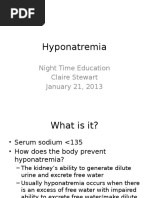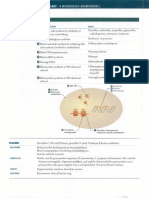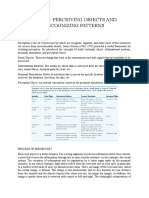0 ratings0% found this document useful (0 votes)
171 viewsOPTOMED-HW2-Diabetic Retinopathy PDF
OPTOMED-HW2-Diabetic Retinopathy PDF
Uploaded by
Danalie SalvadorThis document discusses the ocular manifestations of diabetes mellitus, specifically diabetic retinopathy. It describes diabetic retinopathy as damage to the retina's blood vessels caused by high blood sugar levels from diabetes. It outlines the two types: non-proliferative diabetic retinopathy characterized by microaneurysms, hemorrhages, hard exudates and cotton wool spots. Proliferative diabetic retinopathy is characterized by neovascularization, vitreous hemorrhage, tractional retinal detachment and subhyaloid hemorrhage.
Copyright:
© All Rights Reserved
Available Formats
Download as PDF, TXT or read online from Scribd
OPTOMED-HW2-Diabetic Retinopathy PDF
OPTOMED-HW2-Diabetic Retinopathy PDF
Uploaded by
Danalie Salvador0 ratings0% found this document useful (0 votes)
171 views3 pagesThis document discusses the ocular manifestations of diabetes mellitus, specifically diabetic retinopathy. It describes diabetic retinopathy as damage to the retina's blood vessels caused by high blood sugar levels from diabetes. It outlines the two types: non-proliferative diabetic retinopathy characterized by microaneurysms, hemorrhages, hard exudates and cotton wool spots. Proliferative diabetic retinopathy is characterized by neovascularization, vitreous hemorrhage, tractional retinal detachment and subhyaloid hemorrhage.
Original Title
OPTOMED-HW2-Diabetic Retinopathy.pdf
Copyright
© © All Rights Reserved
Available Formats
PDF, TXT or read online from Scribd
Share this document
Did you find this document useful?
Is this content inappropriate?
This document discusses the ocular manifestations of diabetes mellitus, specifically diabetic retinopathy. It describes diabetic retinopathy as damage to the retina's blood vessels caused by high blood sugar levels from diabetes. It outlines the two types: non-proliferative diabetic retinopathy characterized by microaneurysms, hemorrhages, hard exudates and cotton wool spots. Proliferative diabetic retinopathy is characterized by neovascularization, vitreous hemorrhage, tractional retinal detachment and subhyaloid hemorrhage.
Copyright:
© All Rights Reserved
Available Formats
Download as PDF, TXT or read online from Scribd
Download as pdf or txt
0 ratings0% found this document useful (0 votes)
171 views3 pagesOPTOMED-HW2-Diabetic Retinopathy PDF
OPTOMED-HW2-Diabetic Retinopathy PDF
Uploaded by
Danalie SalvadorThis document discusses the ocular manifestations of diabetes mellitus, specifically diabetic retinopathy. It describes diabetic retinopathy as damage to the retina's blood vessels caused by high blood sugar levels from diabetes. It outlines the two types: non-proliferative diabetic retinopathy characterized by microaneurysms, hemorrhages, hard exudates and cotton wool spots. Proliferative diabetic retinopathy is characterized by neovascularization, vitreous hemorrhage, tractional retinal detachment and subhyaloid hemorrhage.
Copyright:
© All Rights Reserved
Available Formats
Download as PDF, TXT or read online from Scribd
Download as pdf or txt
You are on page 1of 3
SALVADOR, DANALIE C.
OD6C
OCULAR MANIFESTATIONS OF DIABETES MELLITUS
DIABETIC RETINOPATHY
- is a complication of diabetes that causes damage to the blood vessels of the retina.
- the primary cause of diabetic retinopathy is diabetes—a condition in which the levels of glucose
(sugar) in the blood are too high. Elevated sugar levels from diabetes can damage the small blood
vessels that nourish the retina and may, in some cases, block them completely.
TYPES OF DIABETIC RETINOPATHY:
A. NON-PROLIFERATIVE DIABETIC RETINOPATHY
Characterized by the following findings:
MICROANEURYSMS INTRARETINAL HEMORRHAGES:
-are the earliest clinically visible Dot/Blot or Splinter
changes of diabetic retinopathy. hemorrhages.
- localised capillary dilatations which -hemorrhage within the
are usually saccular (round). nerve fibre layer tends to
be flame shaped,
following the divergence
of axons.
-in the inner layer,
haemorrhage is aligned at
right angles to the retinal
surface and is
consequently viewed end-on when using an
ophthalmoscope; these haemorrhages appear dot or blot
shaped.
HARD EXUDATES COTTON WOOL SPOTS
-are distinct yellow-white intra-retinal -are greyish-white
deposits which can vary from small patches of discoloration
specks to larger patches in the nerve fibre layer
which have indistinct
(fluffy) edges.
- multiple cotton wool
spots (more than 6 in one
eye) indicate generalised
retinal ischaemia and this
is regarded as a pre-proliferative state
VENOUS ABNORMALITIES INTRARETINAL MICROVASCULAR ABNORMALITIES (IRMAs)
Venous dilatation, beading and -areas of capillary
duplication. dilatation and intraretinal
new vessel formation
-arise within ischaemic
retina and when they are
present in numbers are a
feature of pre-proliferative
retinopathy
B. PROLIFERATIVE DIABETIC RETINOPATHY
Characterized by the following findings:
NEOVASCULARIZATION VITREOUS HEMORRHAGE
-as the retina becomes more ischaemic new -vitreous haemorrhage can give rise to
blood vessels may arise from the optic disc or in profound loss of vision if the macula is
the periphery of the retina. obscured.
1. Neovascularization at the Disc (NVD)
2. Neovascularization Elsewhere (NVE)
TRACTIONAL RETINAL DETACHMENT SUBHYALOID HEMORRHAGE
-as the new vessels mature, connective tissue -where there is localised detachment of the
and fibrosis (gliosis) occurs allowing the vitreous vitreous blood can accumulate between the
to exert traction which may cause retinal retina and the vitreous adopting the
detachment. characteristic appearance of a subhyaloid
haemorrhage.
-this is often said to be boat-shaped (in this
case the boat has clearly capsized).
You might also like
- (PDF Download) Biopsychology, Global Edition, 11th Ed John Pinel Fulll ChapterDocument62 pages(PDF Download) Biopsychology, Global Edition, 11th Ed John Pinel Fulll Chaptertriboezadin50% (2)
- Opthalmology Visuals New PDF-1Document100 pagesOpthalmology Visuals New PDF-1singh0% (1)
- (Detail Practice) Axel Buether - Colour-Detail (2014)Document122 pages(Detail Practice) Axel Buether - Colour-Detail (2014)Francoise PamfilNo ratings yet
- SketchyPath ChecklistDocument1 pageSketchyPath ChecklistGabriella RosinaNo ratings yet
- Pathoma ChartsDocument73 pagesPathoma ChartsRa Vi100% (1)
- Lange Smart Charts: Pharmacology, 2e Medications Affecting Cardiac and Renal FunctionDocument2 pagesLange Smart Charts: Pharmacology, 2e Medications Affecting Cardiac and Renal FunctionSaulNo ratings yet
- Handbook of Pediatric Eye and Systemic Disease PDFDocument650 pagesHandbook of Pediatric Eye and Systemic Disease PDFBangun Said SantosoNo ratings yet
- Ophthalmology CurriculumDocument71 pagesOphthalmology CurriculumEdoga Chima EmmanuelNo ratings yet
- Syncope and PalpitationsDocument1 pageSyncope and PalpitationsTom MallinsonNo ratings yet
- Essential Update: FDA Approves First Test To Predict AKI in Critically Ill PatientsDocument5 pagesEssential Update: FDA Approves First Test To Predict AKI in Critically Ill PatientsRika Ariyanti SaputriNo ratings yet
- A To Z Diseases LISTS For NEETPGDocument5 pagesA To Z Diseases LISTS For NEETPGQworldNo ratings yet
- Antiarrhythmic Drugs: 1A: Prolong AP & Increase Refractory Period Moderate Effects On Conduction in Normal CellsDocument6 pagesAntiarrhythmic Drugs: 1A: Prolong AP & Increase Refractory Period Moderate Effects On Conduction in Normal CellsSaulNo ratings yet
- F5 DialyzerDocument2 pagesF5 DialyzerDani ursNo ratings yet
- Renal SyndromeDocument13 pagesRenal SyndromeAndreas KristianNo ratings yet
- Study Product 1Document117 pagesStudy Product 1javibruinNo ratings yet
- Vascular Approach & ExamDocument17 pagesVascular Approach & Exammotasem.med120No ratings yet
- HyponatremiaDocument19 pagesHyponatremiaapi-260357356No ratings yet
- Nsaid: Pharmakokinetics Pharmakodynamics CU AE CI DI Salicylic AcidDocument2 pagesNsaid: Pharmakokinetics Pharmakodynamics CU AE CI DI Salicylic AcidjessmasakiNo ratings yet
- Meds For HypertensionDocument3 pagesMeds For HypertensionZonicsNo ratings yet
- Nephrologi NotesDocument43 pagesNephrologi NotesSigit Harya HutamaNo ratings yet
- Cardiology Arteritis ChartDocument3 pagesCardiology Arteritis ChartM PatelNo ratings yet
- Vasculitis: Disorder Vessels Pathology Presentation Test TX OtherDocument3 pagesVasculitis: Disorder Vessels Pathology Presentation Test TX OthermcwnotesNo ratings yet
- Ophthalmology - Passmedicine 2012 - 62013146Document18 pagesOphthalmology - Passmedicine 2012 - 62013146abuahmed&janaNo ratings yet
- Labs 1.19 ABG AnalysisDocument1 pageLabs 1.19 ABG AnalysisMonica GonzalezNo ratings yet
- Anemia ChartsDocument6 pagesAnemia ChartsLiz100% (1)
- Toronto Notes Nephrology 2015 22Document1 pageToronto Notes Nephrology 2015 22JUSASB0% (1)
- First Aid PharmacoDocument61 pagesFirst Aid PharmacogirNo ratings yet
- Chart - WBC DisordersDocument1 pageChart - WBC DisordersSamuel RothschildNo ratings yet
- Alarm Symptoms of Hematoonco in Pediatrics: Dr. Cece Alfalah, M.Biomed, Sp.A (K) Pediatric Hematology and OncologyDocument22 pagesAlarm Symptoms of Hematoonco in Pediatrics: Dr. Cece Alfalah, M.Biomed, Sp.A (K) Pediatric Hematology and OncologyMuhammad ArifNo ratings yet
- Summary 1Document133 pagesSummary 1Miss LindiweNo ratings yet
- Diseases - BiochemDocument4 pagesDiseases - BiochemJay FeldmanNo ratings yet
- Drugs of ChoiceDocument2 pagesDrugs of ChoiceGian Carla SoNo ratings yet
- Approach To TransaminitisDocument20 pagesApproach To Transaminitisparik2321No ratings yet
- Drugs of Choice - CompiledDocument18 pagesDrugs of Choice - CompiledAvinash DesaiNo ratings yet
- OMedEd - Cardiology - CAD PDFDocument2 pagesOMedEd - Cardiology - CAD PDFJohn DoeNo ratings yet
- Causes: With Cardiorenal SyndromeDocument12 pagesCauses: With Cardiorenal SyndromeActeen MyoseenNo ratings yet
- Cardiac Drugs HypertensionDocument5 pagesCardiac Drugs HypertensionEciOwnsMeNo ratings yet
- Download PreTest Emergency Medicine 5th Edition Edition Adam J. Rosh ebook All Chapters PDFDocument41 pagesDownload PreTest Emergency Medicine 5th Edition Edition Adam J. Rosh ebook All Chapters PDFrohitareasix100% (3)
- Cardio 2 - X-RayDocument45 pagesCardio 2 - X-RaySaja SaqerNo ratings yet
- Upper Motor Neuron Lesions (UMNL) / Pyrimidal Insufficiency Lower Motor Neuron Lesions (LMNL)Document2 pagesUpper Motor Neuron Lesions (UMNL) / Pyrimidal Insufficiency Lower Motor Neuron Lesions (LMNL)Jared Khoo Er Hau100% (1)
- Internal Medicine #1Document167 pagesInternal Medicine #1Nikhil RayarakulaNo ratings yet
- Bot Med Final CHARTDocument33 pagesBot Med Final CHARTapi-26938624100% (3)
- CVS Tables FranzDocument7 pagesCVS Tables FranzCole GoNo ratings yet
- Drugs For Heart Failure: Drugs Catego Ry Drug Function Adverse Effect NoteDocument2 pagesDrugs For Heart Failure: Drugs Catego Ry Drug Function Adverse Effect NoteyukariNo ratings yet
- Diabetes Treatment: PancreatitisDocument2 pagesDiabetes Treatment: PancreatitisSafiya JamesNo ratings yet
- Clinical Medicine - Lecture: - Topic: - DateDocument3 pagesClinical Medicine - Lecture: - Topic: - DateqselmmNo ratings yet
- Posterior Pituitary SyndromeDocument1 pagePosterior Pituitary SyndromeGerardLumNo ratings yet
- Hematology Oncology - LymphomaDocument1 pageHematology Oncology - LymphomaEugen MNo ratings yet
- Renal Osmosis HY Pathology Notes ATF - ATFDocument109 pagesRenal Osmosis HY Pathology Notes ATF - ATFTran Thai Huynh NgocNo ratings yet
- SIADH and Reset OsmostatDocument7 pagesSIADH and Reset Osmostatsaleema11No ratings yet
- Internal Medicine Topic List 2015Document3 pagesInternal Medicine Topic List 2015Krystal Mae LopezNo ratings yet
- Management of Severe Hypertension, Hypertension in Special ConditionDocument43 pagesManagement of Severe Hypertension, Hypertension in Special Conditionabhandlung100% (3)
- Characterstic Drug ToxicitiesDocument3 pagesCharacterstic Drug ToxicitiesJorge PalazzoloNo ratings yet
- Diabetic Microvascular DiseaseDocument68 pagesDiabetic Microvascular DiseasePavel GonzálezNo ratings yet
- Parathyroid Glands: Serum PTH Levels Are Inappropriately Elevated For The LevelDocument4 pagesParathyroid Glands: Serum PTH Levels Are Inappropriately Elevated For The LevelNada MuchNo ratings yet
- IM DailyDocument1 pageIM DailySylvanusNo ratings yet
- Plasma Cell Dyscrasias Testing Algorithm PDFDocument1 pagePlasma Cell Dyscrasias Testing Algorithm PDFolesyaNo ratings yet
- One Stop Doc Endocrine and Reproductive SystemsDocument129 pagesOne Stop Doc Endocrine and Reproductive SystemsاناكافرNo ratings yet
- Ioc Gold StandardDocument6 pagesIoc Gold StandardjohnNo ratings yet
- Coats' Disease and Retinal TelangiectasiaDocument6 pagesCoats' Disease and Retinal TelangiectasiaAndreas SatriaNo ratings yet
- Macroscopic Diagnostic For Pathoanathomy and Cytopathology ExamDocument21 pagesMacroscopic Diagnostic For Pathoanathomy and Cytopathology Examkapil pancholiNo ratings yet
- Retina and Vitreous: OphthalmologyDocument14 pagesRetina and Vitreous: OphthalmologyPrincess Noreen SavellanoNo ratings yet
- Manual of Retinal Diseases A Guide To Diagnosis and Management 1st Edition 2016 EditionDocument588 pagesManual of Retinal Diseases A Guide To Diagnosis and Management 1st Edition 2016 EditionApostolos T.No ratings yet
- Retinopati HipertensiDocument24 pagesRetinopati HipertensiAndi YongkiNo ratings yet
- What A Plant Knows - A Field Guide To The Senses of Your Garden - and Beyond - Daniel ChamovitzDocument17 pagesWhat A Plant Knows - A Field Guide To The Senses of Your Garden - and Beyond - Daniel ChamovitzAndré Spinoza De CastroNo ratings yet
- PreviewpdfDocument167 pagesPreviewpdfRani AprianiNo ratings yet
- Eye Docs RetinaDocument279 pagesEye Docs RetinaRahul LokhandeNo ratings yet
- (Ebook PDF) Sensation and Perception 2nd Edition by Bennett L. Schwartz 2024 Scribd DownloadDocument51 pages(Ebook PDF) Sensation and Perception 2nd Edition by Bennett L. Schwartz 2024 Scribd Downloadsanchesheay100% (4)
- Sensation and PerceptionDocument13 pagesSensation and PerceptionRiza Roncales100% (1)
- Hereditary Eye Disease in Dogs PDFDocument16 pagesHereditary Eye Disease in Dogs PDFJéssica CaetanoNo ratings yet
- IELTS Maximizer 100 Reading PRint MyselfDocument52 pagesIELTS Maximizer 100 Reading PRint Myselfmichael noneNo ratings yet
- Human Factor AMTDocument109 pagesHuman Factor AMTJaafar AliNo ratings yet
- Color Atlas of Retina and Optic NerveDocument371 pagesColor Atlas of Retina and Optic NervefabioNo ratings yet
- Ch. 3 Critical Thinking ActivityDocument7 pagesCh. 3 Critical Thinking ActivityYe YusiNo ratings yet
- Basic Anatomy of The Eye, AdnexaDocument31 pagesBasic Anatomy of The Eye, AdnexaYuwan RamjadaNo ratings yet
- Chapter 21 - Zebrafish in Biomedical Research - 2020 - The Zebrafish in BiomediDocument8 pagesChapter 21 - Zebrafish in Biomedical Research - 2020 - The Zebrafish in BiomediNicolas BaronNo ratings yet
- Machado Silva 07 1Document11 pagesMachado Silva 07 1César JuradoNo ratings yet
- Ophthalmology For Lawyers PDFDocument329 pagesOphthalmology For Lawyers PDFAnonymous PYgnwOWKNo ratings yet
- Class 8 Light PDFDocument5 pagesClass 8 Light PDFMamta JoshiNo ratings yet
- Class 8 Light Notes: Laws of ReflectionDocument4 pagesClass 8 Light Notes: Laws of ReflectionHagua MakuaNo ratings yet
- Angio-OCT User's Guide 2014-09-21 PDFDocument17 pagesAngio-OCT User's Guide 2014-09-21 PDFYoselin Herrera GuzmánNo ratings yet
- Unit IVDocument6 pagesUnit IVShoba GuhanNo ratings yet
- Transcription T9Document27 pagesTranscription T9hello worldNo ratings yet
- Artificial Retina Using Thin Film Transistors: Presented by Y.Mounisha 12W51A04A0Document20 pagesArtificial Retina Using Thin Film Transistors: Presented by Y.Mounisha 12W51A04A0Hemanth KumarNo ratings yet
- 13 Special SensesDocument77 pages13 Special SensesDarwin Mangabat100% (3)
- Diabetic Retinopathy - Practice Essentials, Pathophysiology, EtiologyDocument11 pagesDiabetic Retinopathy - Practice Essentials, Pathophysiology, EtiologyIrma Kurniawati100% (1)
- Gehl Machinery Heavy Equipment 5 29 Gb PDF 2022 Operator Manuals DvdDocument28 pagesGehl Machinery Heavy Equipment 5 29 Gb PDF 2022 Operator Manuals DvdbbqfainyNo ratings yet
- QPD Sensation and Perception Final PeppcetDocument48 pagesQPD Sensation and Perception Final PeppcetsayyidshaheerNo ratings yet

























































































